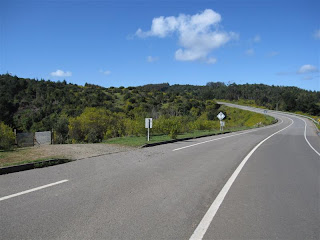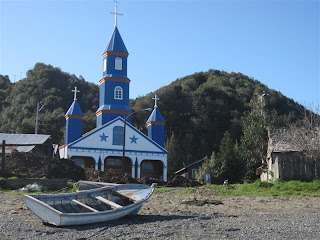
Calling Chile my Home: I have been struggling to write this blog post. How do I draw conclusions from my last four months in Chile? How can I ever wrap-up my time here? Reading through some journal entries that I wrote before leaving, I realize that I never could have guessed what my time here would be like. What did I know about Chile before? I knew about the dictatorship, its unique geography, and Pablo Neruda. What do I know now? This blog only contains a sample of all that I have learned about this country. Despite my frustrations with the strikes, my fierce love for this country and its people remains intact.
When I recently traveling with some other Americans in Argentina, I noticed that I was the only one of us that introduced myself as being from Chile. At first glance, I thought that it was just a technicality. I wanted to identity myself with my Chilean family and my work here, while the others still considered themselves foreigners. After some more thought, I realized that part of me identifies now as being Chilean. In the United States, I straddle between my life in California and my life in Rhode Island without firm roots in either. Whereas in Chile, with a house, with a job, and with a family I feel at home. While I am leaving this home for now, I have promised myself (and my Chilean family) that I will someday return.
It has been challenging to write my “Statement of Purpose” for grad school in Chile. Living in the United States seems like a long time ago now even though I was there only four months ago. How has my time here changed my interests, my aspirations, and my values? Trying to remember my life before Chile and weaving it together with my life here is more challenging than I realized. Before I left, teaching English in Chile seemed like a logical extension of my growth as a teacher and I thought it would affirm my decision to become a teacher in the United States. But after living here for the last four months, I wonder if I even want to go to grad school at all? Maybe being cut off from everything just gives me a certain distance from it and a chance to view everything as an outsider rather than from within. Whatever the case, I am grateful to have this time to just think and I know that I will leave my time here with more clarity and conviction than I had when I arrived.
Only in the "Skinny One" (Being Azn in Chile): My time in Chile has also given me a lot to think about being Asian. At Brown, I was a multiracial of Japanese descent (a hapa) and in Chile, I am just a chino (a Chinaman). While I should feel offended that my hard-won ethnic identity is being trivialized into a racial slur, my Asianess has become one of my chief identifying characteristics here in Los Alamos.
My conversations about being Asian usually go something like this:
Curious Chilean: Where are you from?
Me: I am from the United States.
Curious Chilean: [Looks at me confused]
Me: I am from the United States, but my mom is Japanese.
Curious Chilean: Oh [sounding relieved], I thought so. I could tell by your eyes [demonstrating with her own eyes].
Curious Chilean: Do you do Karate?
Me: No
Curious Chilean: That's too bad. I love movies with Jackie Chan.
Curious Chilean: I have something embarrassing to ask you.
Me: What's that?
Curious Chilean: Is it true that they really eat dog in China?
Me: I don't really know, but I have heard that. It's not really that different from eating fried Guinea Pig in Peru.
Curious Chilean: [Ignoring what I just said and looking shocked] I could never eat my dog. Do you know how to eat with chopsticks?
Me: Yes [demonstrating using two pencils as substitutes]
Curious Chilean: Look! Look! The Chinaman is using sticks to eat.
Chileans clearly have a fascination with Asians. Several of my Chilean students who appear slightly Asian go by the nicknames “Chino” or “China.” TV shows like Dragon Ball Z, Yu-Gi-Oh, Pokemon, and other anime are wildly popular amongst my students. There are cliques of Chilean youth that dress like Japanese anime characters (the “Otakus” and the “Pokemones”). Peru, Chile's Northern neighbor even had a Japanese president (Alberto Fujimori) for ten years from 1990-2000. Maybe what feels like discrimination to me is just a little bit of hero worship.
Finding Davis in South America: A few weeks ago, I finally crossed the border into Argentinean Patagonia (I also got the gratification of seeing the same border guard who refused to let me cross two months earlier). My first stops were San Martin de los Andes and Bariloche which are vacation destinations for Argentina's rich and famous. After living in working-class rural Chile for the last four months, it was a shock to know that such opulence even existed alongside places like Los Alamos. While it was alluring to again be in such a beautiful and wealthy environmental, I would not trade anything for my backyard asados in Los Alamos.
The highlight of the trip for me was going to El Bolsón, a hippy town located in a valley surrounded by snow-capped Andes. Full of outdoor artwork, large grassy parks, and locally-owned organic restaurants, the town reminded me of a similar hippy town 5,000 miles away—Davis, California. The focus of my visit to El Bolsón was an outdoor crafts fair which seem eerily similar to Davis' annual Whole Earth Festival. Vendor after vendor sold hand-made knit hats, wooden kitchenware, colorful puppets, organic food, and musical instruments. Walking through the crafts fair with the sun shining down on me, I couldn't help but smile. Even in a place where I least would least expect it, a small Andean town just across the Argentine border, I was surrounded by reminders of home.
Ready to Hit the Road: Having completed my teaching term in Chile, it is time to embark on my travels. My first destination is Southern Patagonia. I am backpacking in Torres del Paine National Park for a week, camping another week in Los Glaciares National Park, and then making my way down to Tierra del Fuego at the southern tip of South America. After Patagonia, I will be celebrating Christmas with my Davis family in Valparaiso and then we are making a quick visit to my host-family, stopping back through the Chilean wine country.
After the visit from my family I am heading North towards Bolivia to see the drier parts of Chile. I am going to La Serena to sample pisco, see penguins, and admire the stars. Then I will be spending a couple days in San Pedro de Atacama to sandboard, visit the salt flats, and enjoy the beauty of the dessert. A Jeep trip will take me across the border into Bolivia and then I will be visiting more exotic landscapes in Bolivia's altiplano and central highlands. Finally arriving at La Paz, the highest capital city in the world, at over 12,000 feet above sea level, just in time for its world-famous Alasitas Fair.
My current plans stop in La Paz. From that juncture I might head South East towards Salta, Buenos Aires, and Iguazu Falls or continue North to Peru, Ecuador, and finally Columbia. I have made up my mind not to extend my teaching in Chile, but other volunteer work (farm-work, orphanages, and post-earthquake recovery) in lesser-developed areas is my latest plan. There is a virgin beauty here that much of the United States has lost in its urban cement jungles. Four months here in Chile whetted my appetite to explore South America, but I think I am ready to move on from the “Skinny One."

















































